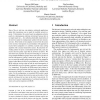Free Online Productivity Tools
i2Speak
i2Symbol
i2OCR
iTex2Img
iWeb2Print
iWeb2Shot
i2Type
iPdf2Split
iPdf2Merge
i2Bopomofo
i2Arabic
i2Style
i2Image
i2PDF
iLatex2Rtf
Sci2ools
SIGCOMM
1996
ACM
1996
ACM
Receiver-Driven Layered Multicast
State of the art, real-time, rate-adaptive, multimedia applications adjust their transmission rate to match the available network capacity. Unfortunately, this source-based rate-adaptation performs poorly in a heterogeneous multicast environment because there is no single target rate -- the conflicting bandwidth requirements of all receivers cannot be simultaneously satisfied with one transmission rate. If the burden of rate-adaption is moved from the source to the receivers, heterogeneity is accommodated. One approach to receiver-driven adaptation is to combine a layered source coding algorithm with a layered transmission system. By selectively forwarding subsets of layers at constrained network links, each user receives the best quality signal that the network can deliver. We and others have proposed that selective-forwarding be carried out using multiple IP-Multicast groups where each receiver specifies its level of subscription by joining a subset of the groups. In this paper, we ...
| Added | 08 Aug 2010 |
| Updated | 08 Aug 2010 |
| Type | Conference |
| Year | 1996 |
| Where | SIGCOMM |
| Authors | Steven McCanne, Van Jacobson, Martin Vetterli |
Comments (0)

